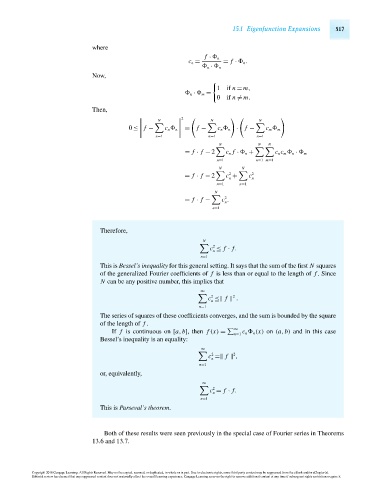Page 537 - Advanced_Engineering_Mathematics o'neil
P. 537
15.1 Eigenfunction Expansions 517
where
f · n
c n = = f · n .
n · n
Now,
1if n = m,
n · m =
0if n = m.
Then,
2
N N N
0 ≤ f − c n n = f − c n n · f − c m m
n=1 n=1 n=1
N N N
= f · f − 2 c n f · n + c n c m n · m
n=1 n=1 m=1
N N
2
= f · f − 2 c + c 2
n n
n=1 n=1
N
2
= f · f − c .
n
n=1
Therefore,
N
2
c ≤ f · f.
n
n=1
This is Bessel’s inequality for this general setting. It says that the sum of the first N squares
of the generalized Fourier coefficients of f is less than or equal to the length of f . Since
N can be any positive number, this implies that
∞
2 2
c ≤ f .
n
n=1
The series of squares of these coefficients converges, and the sum is bounded by the square
of the length of f .
∞
If f is continuous on [a,b], then f (x) = c n n (x) on (a,b) and in this case
n=1
Bessel’s inequality is an equality:
∞
2
2
c = f ,
n
n=1
or, equivalently,
∞
2
c = f · f.
n
n=1
This is Parseval’s theorem.
Both of these results were seen previously in the special case of Fourier series in Theorems
13.6 and 13.7.
Copyright 2010 Cengage Learning. All Rights Reserved. May not be copied, scanned, or duplicated, in whole or in part. Due to electronic rights, some third party content may be suppressed from the eBook and/or eChapter(s).
Editorial review has deemed that any suppressed content does not materially affect the overall learning experience. Cengage Learning reserves the right to remove additional content at any time if subsequent rights restrictions require it.
October 14, 2010 15:20 THM/NEIL Page-517 27410_15_ch15_p505-562

